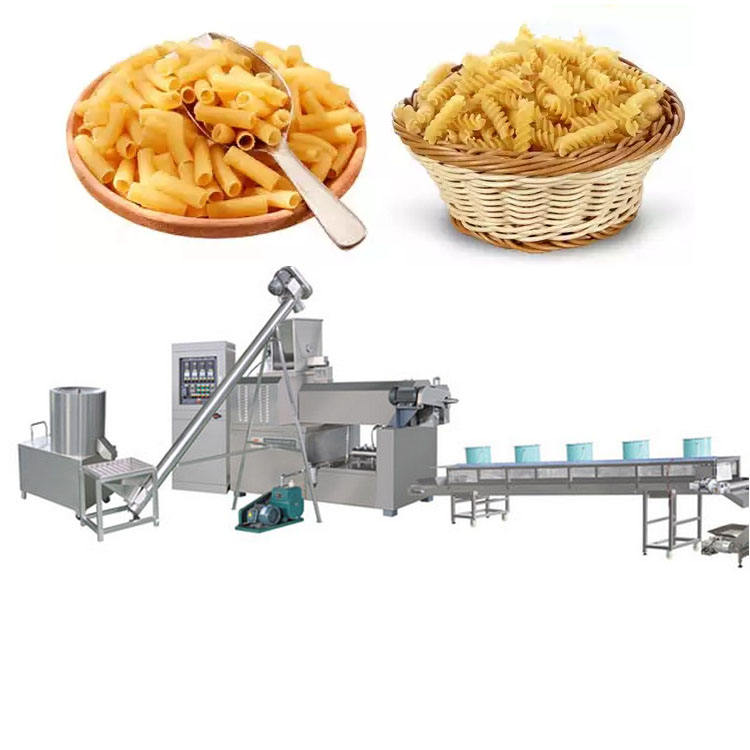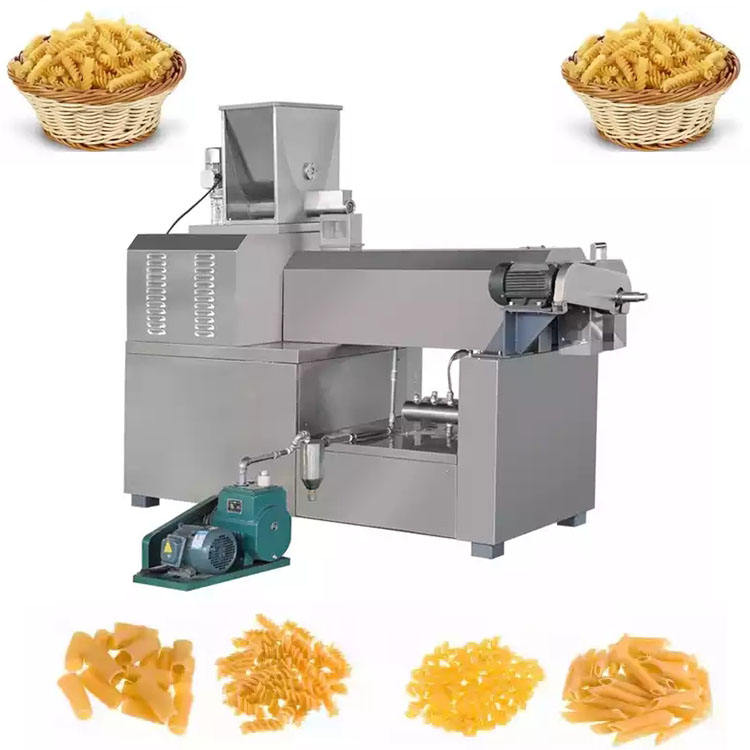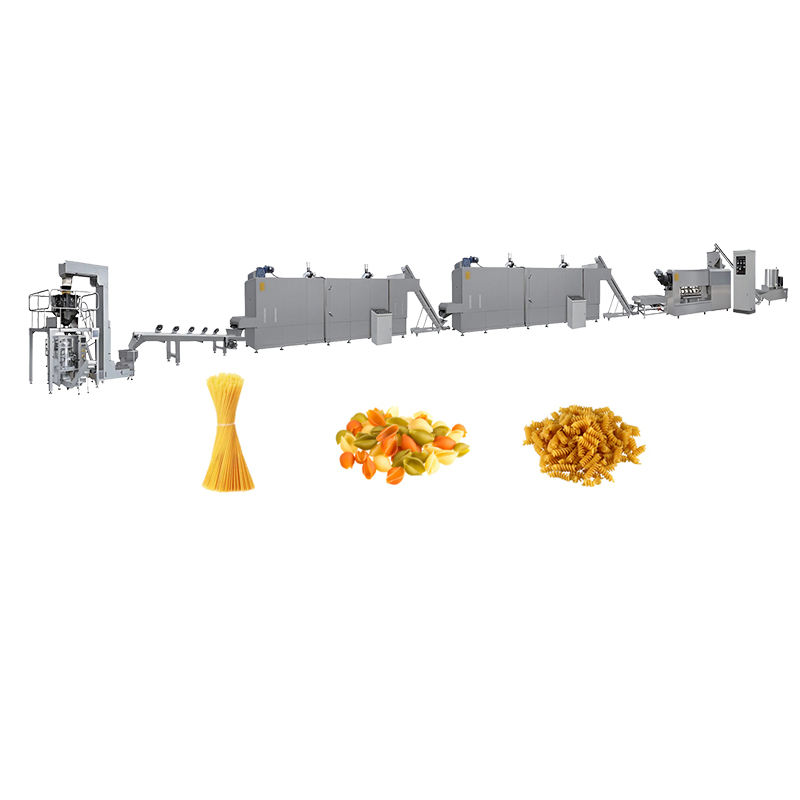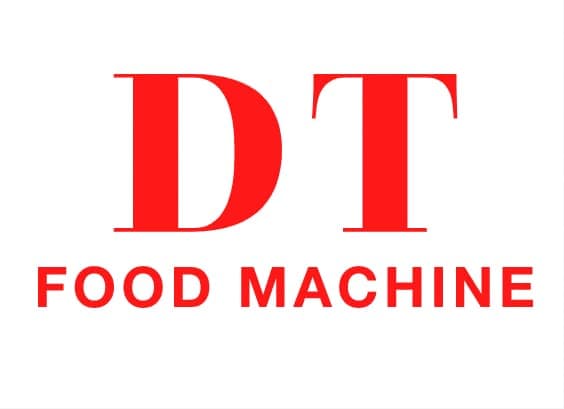Di industri pengolahan makanan modern, A Macaroni Line refers to an automated production line dedicated to manufacturing macaroni pasta. These lines are used in both small-scale artisanal setups and large-scale industrial pasta factories. With increasing global demand for pasta, the efficiency, otomatisasi, and hygiene of the macaroni production process have become more vital than ever.
The Macaroni Line encompasses a series of interconnected machines working in synchronization to produce consistent, high-quality macaroni. This includes dough mixing, extrusion, pemotongan, pengeringan, pendinginan, and packaging — all designed to minimize manual intervention and maximize output.

1. Components of a Typical Macaroni Line
To fully understand what a Macaroni machine line is, it’s essential to break down its major components. Below is a list of the core machinery involved:
1.1 Dough Mixing System
- Mixes semolina flour and water to form homogeneous dough.
- Often includes vacuum mixers to remove air bubbles.
1.2 Extruder (Macaroni Extrusion Machine)
- Forces dough through specific dies to form macaroni shapes.
- Includes a cooling system to regulate temperature during extrusion.
1.3 Cutting System
- Uses high-speed rotary knives to cut pasta into uniform lengths.
1.4 Pre-Dryer or Pre-Conditioning Chamber
- Stabilizes moisture content before the final drying process.
1.5 Pasta Dryer
- Multi-zone dryer for reducing moisture content to ~12.5%.
- Can be batch-type or continuous tunnel-type.
1.6 Sistem pendingin
- Cools dried pasta to room temperature to avoid condensation.
1.7 Mesin pengemasan
- Beratnya, bags, and seals macaroni for retail or bulk sale.

2. Macaroni Line Process Flow: Step-by-Step Breakdown
2.1 Ingredient Preparation
Semolina (a coarse wheat flour) is the key ingredient. Water is added in a specific ratio (typically 25–30%) to form the dough.
2.2 Pencampuran Adonan
Advanced mixers ensure the mixture is evenly hydrated. Mixing duration and speed can be digitally controlled.
2.3 Ekstrusi & Membentuk
The dough passes through the macaroni extruder and dies, forming hollow tubes or elbow shapes. Pressure and screw speed determine the output quality.
2.4 Pemotongan
Rotating knives slice macaroni to precise lengths (usually 3–5 cm).
2.5 Pengeringan
Drying is a critical step affecting texture, mencicipi, and shelf-life. Multi-stage dryers manage temperature (50–90 ° C.), airflow, and humidity.
2.6 Pendinginan
Macaroni is gradually cooled to room temperature (~25°C) to prevent cracking or mold growth.
2.7 Sedang mengemas
Using form-fill-seal machines or vertical bagging systems, the final macaroni is sealed in food-grade packaging.
3. Technical Specifications of Macaroni Line Machines
| Komponen | Spesifikasi |
|---|---|
| Capacity Range | 100 kg/h to 1500 kg/jam |
| Mixer Power | 5–10 kW |
| Extruder Screw Speed | 20–80 RPM |
| Dryer Temperature Range | 50–90 ° C. |
| Dryer Zones | 3–5 zones |
| Daya Terpasang | 60–200 kW (varies by size) |
| Material Construction | Stainless steel grade makanan (SS304/SS316) |
| Level Otomasi | Semi-automatic to fully automatic |

4. Macaroni Line Configurations: Kecil, Sedang, and Large Scale
4.1 Small-Scale Macaroni Line
- Kapasitas: 100–300kg/jam
- Suitable for local pasta businesses
- Investasi yang terjangkau
- May include semi-automatic packaging
4.2 Medium-Scale Macaroni Line
- Kapasitas: 500–800kg/jam
- Higher degree of automation
- Designed for regional distribution
4.3 Industrial Macaroni Line
- Kapasitas: 1000–1500+ kg/hour
- Continuous production
- Fully automated control panels and SCADA integration
- Cip (Bersih di Tempatnya) systems for hygiene
5. Macaroni Line Shapes and Dies
The macaroni line is versatile and supports multiple pasta shapes by simply changing extrusion dies. Popular options include:
- Makaroni siku
- Straight tubes
- Penne rigate
- Ziti
- Shells
- Fusilli (requires additional curling mechanism)
Custom dies are made from bronze or Teflon-coated steel, with bronze giving a rough surface for sauce adherence.

6. Benefits of a Modern Macaroni Line
6.1 Efisiensi
Fully automated lines drastically reduce labor and increase output.
6.2 Konsistensi
Standardized drying and extrusion parameters ensure uniform quality.
6.3 Kebersihan
Stainless steel construction and sealed systems prevent contamination.
6.4 Skalabilitas
Modular designs allow future expansion or integration with other pasta lines.
7. Energy and Water Consumption
| Sumber | Consumption per 1000kg of Macaroni |
|---|---|
| Listrik | ~150–200 kWh |
| Air | ~250–350 liters |
| Udara Terkompresi | 5–7 m³/hr |
Energy efficiency features like heat recovery systems and variable frequency drives (VFDs) can reduce operating costs.
8. Common Issues and Troubleshooting in Macaroni Lines
8.1 Uneven Drying
Menyebabkan: Poor airflow or incorrect humidity.
Larutan: Calibrate dryer zones and check sensors.
8.2 Product Cracking
Menyebabkan: Rapid cooling or low moisture control.
Larutan: Optimize drying and cooling curve.
8.3 Blocked Extruder
Menyebabkan: Dough too dry or pressure buildup.
Larutan: Check water ratio and die plate condition.
9. RFQ – Frequently Asked Questions When Buying a Macaroni Line
Q1: What capacity should I choose?
A: It depends on your target market. Small-scale lines suit local shops; large-scale setups serve export or wholesale.
Q2: Berapa lama waktu pemasangannya?
A: Typical installation takes 10–30 days depending on capacity and site preparation.
Q3: Is operator training included?
A: Ya, most manufacturers include training and a complete user manual.
Q4: What certifications are needed?
A: Ce, Iso, and FDA-compliant materials are standard. Check local food safety regulations.
Q5: Can the machine produce other pasta types?
A: Ya, by changing dies, you can produce multiple pasta shapes.
Q6: Berapa masa garansinya?
A: Standard warranty is 12–24 months with lifetime technical support.
Q7: How is the equipment cleaned?
A: Many systems use CIP (Bersih di Tempatnya) modules. Manual cleaning is possible with smaller lines.
Q8: What raw materials are used?
A: Durum wheat semolina, air, and optional additives like vitamins or natural colors.
Q9: Can I customize the packaging system?
A: Ya, packaging machines can be tailored for different bag sizes and sealing methods.
Q10: How do I ensure the quality of finished macaroni?
A: Regular testing of moisture, tekstur, and dimensions ensures product quality.
10. Global Suppliers of Macaroni Lines
Some of the leading suppliers of macaroni lines include:
- Grup Pavan (Italia)
- Bühler AG (Swiss)
- Anko Food Machine Co. (Taiwan)
- Mesin Makanan DT (Cina)
- FENCO (Italia)
When selecting a supplier, consider local support, ketersediaan suku cadang, dan efisiensi energi.
11. Investment and ROI in Macaroni Production Lines
The cost of a Macaroni Line varies:
| Skala produksi | Perkiraan biaya (USD) |
|---|---|
| Kecil (100–300kg/jam) | $30,000–$60.000 |
| Sedang (500–800kg/jam) | $70,000–$120,000 |
| Besar (1000+ kg/jam) | $150,000–$300.000 |
Pengembalian investasi (ROI) can be achieved within 1–2 years, depending on market demand, strategi penetapan harga, and operational efficiency.
12. Future Trends in Macaroni Line Technology
- AI-Powered Quality Control: Using computer vision for defect detection.
- Energy Recovery Systems: Recycling heat from dryers.
- Modular Compact Designs: For urban factories.
- Pemantauan IoT: For real-time maintenance alerts and efficiency tracking.
- Plant-Based Ingredient Adaptation: Macaroni made from lentils, chickpeas, or quinoa.
Kesimpulan: Why Choose a Macaroni Line for Pasta Manufacturing?
Itu Macaroni Line is a cornerstone of modern pasta production. Whether you’re a startup entering the market or a large-scale manufacturer expanding operations, investing in a macaroni production line offers reliability, skalabilitas, dan kualitas produk yang konsisten.
With customization, otomatisasi, and the ability to meet strict hygiene standards, the Macaroni Line is a strategic asset in the growing global pasta industry.
